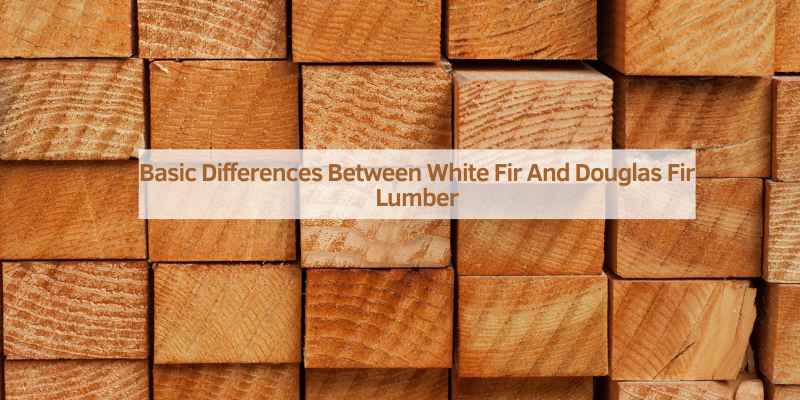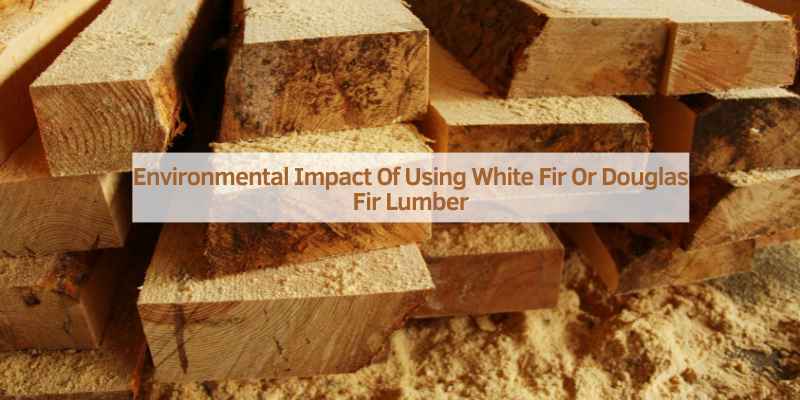White fir and Douglas fir lumber have significant differences in terms of characteristics and uses. White fir is lightweight but strong and suitable for framing lumber, wall and ceiling cladding, and other decorative applications.
Meanwhile, Douglas fir has a more natural appearance, heavy-duty, and often used in construction to carry heavy loads, making it the most common Christmas tree sold in the United States. Additionally, Douglas fir has one-inch long needles that grow in all directions around the branch and can vary in different shades of green on a tree.
On the other hand, white fir has been somewhat overlooked for decades due to the wide variety of other softwoods in the Pacific Northwest. It is also known for its knottier wood and weaker timber tree compared to Douglas fir.
Basic Differences Between White Fir And Douglas Fir Lumber
White fir and Douglas fir lumber differ in their needle growth patterns and characteristics. White fir needles grow all around the branch and have a uniform green color, while Douglas fir needles grow in different directions and vary in shades of green.
While both can be used for framing lumber, white fir is more affordable and commonly used for interior wall and ceiling cladding.
When it comes to selecting the right type of wood for your construction project, it’s important to be knowledgeable about the differences between available options. Two of the most commonly used types of lumber are white fir and Douglas fir. Although they have some similarities, they also have noticeable differences in terms of appearance, characteristics, and best uses.
Color Variation in Needles and Buds
One of the most recognizable differences between white fir and Douglas fir is the color variation in their needles and buds. Douglas fir needles are approximately one inch long and grow in all directions around the branch. They are also flat, friendly, and flexible, and can vary in different shades of green on a tree. On the other hand, white fir needles are slightly shorter and have a bluish-green color. The long, shiny, pointy brown buds of Douglas fir are another distinguishing characteristic.
Characteristics of Wood
When it comes to the characteristics of the wood, white fir is somewhat neglected as compared to Douglas fir, due to the vast range of other softwoods in the Pacific Northwest. However, it is an excellent choice for framing lumber, providing a lightweight but strong material for studs. It is also an affordable solution for interior wall and ceiling cladding and other decorative applications. Meanwhile, Douglas fir is well known for its durability and consistency, making it an excellent choice for outdoor features like decking and fences. It is also commonly used in construction to carry heavy loads.
Best Uses for White Fir and Douglas Fir Lumber
In conclusion, both white fir and Douglas fir lumber have their own set of strengths and weaknesses. It’s crucial to understand these differences to ensure that you’re selecting the right type of wood for your construction projects. If the project requires consistency and durability, Douglas fir is the better choice. In contrast, white fir is an excellent choice for projects that require lightweight strength and affordability. Ultimately, it depends on your project’s unique needs and requirements.

Pros And Cons Of White Fir Lumber
White Fir lumber is a lightweight and strong material that is well-suited for framing lumber and interior wall and ceiling cladding. While it has been overlooked due to the wide variety of other softwoods in the Pacific Northwest, it is an affordable solution for decorative applications.
When compared to Douglas Fir, White Fir has weaker and knottier wood but is still a good option for specific projects and uses.
Strength And Durability
White Fir Lumber has a moderate density, lower than Douglas Fir Lumber but higher than some other softwoods. It is generally strong, stable, and easy to work with. However, it is not as durable as other types of wood, which makes it less than ideal for outdoor applications or areas with high moisture. It is more susceptible to decay and bug infestation, especially when used in direct contact with the soil. It is recommended to apply a protective finish to preserve the wood’s lifespan.
Appearance And Texture
White Fir Lumber is a light-colored wood with a fine, straight grain that gives it a sleek look. It has a smooth texture and can be easily sanded and painted to achieve a desirable finish. It can provide an elegant and modern look to interior decorations, including walls and ceilings, and it is a perfect fit for structural support, such as framing lumber.
Price And Availability
White Fir Lumber is widely available throughout the west coast of the USA, particularly in the Pacific Northwest. It is an affordable wood type with prices that range between lower-priced pine lumber and more expensive hardwoods. Prices may fluctuate depending on location and market prices. However, its availability can be limited in some parts of the country.
In conclusion, White Fir Lumber is a suitable option for interior and structural applications but may not be as durable for outdoor use. It is a cost-effective choice with a sophisticated appearance, and it can be easily found in the Pacific Northwest.
Pros And Cons Of Douglas Fir Lumber
Douglas Fir Lumber is a popular choice for construction projects due to its strength, durability, and versatility. However, like any material, there are pros and cons to using it. Let’s take a closer look at the advantages and disadvantages of Douglas Fir Lumber.
Strength And Durability
Douglas Fir is a strong and durable wood that can easily handle heavy loads, making it ideal for construction projects. It is also resistant to decay, moisture, and insects, making it a reliable choice for outdoor structures. However, it can be prone to splitting and warping, especially if not treated correctly.
Appearance And Texture
Douglas Fir Lumber has a light reddish-brown color with noticeable grain patterns. Its texture is relatively smooth with occasional knots that add character to the wood. It is a popular choice for decorative applications due to its attractive appearance. However, some people may prefer a more uniform look, which could make Douglas Fir less desirable for some projects.
Price And Availability
Douglas Fir Lumber is widely available and relatively affordable, making it a popular choice for both homeowners and contractors. However, the price can vary depending on the location, quality, and size of the wood. It is essential to source the wood from a reputable supplier to ensure the quality and avoid defects.
| Pros | Cons |
|---|---|
| Strong and durable | Prone to splitting and warping |
| Attractive appearance | Not always uniform in texture |
| Relatively affordable | Varying prices depending on location and quality |
| Widely available | Quality can vary depending on supplier |
Overall, Douglas Fir Lumber is an excellent choice for construction projects due to its strength, durability, and versatility. However, it is crucial to consider the pros and cons carefully before choosing it for your project. With proper treatment and care, Douglas Fir can perform well and last for many years.
Which Is Better For Interior And Exterior Applications?
Choosing between White Fir and Douglas Fir Lumber for interior and exterior applications depends on your project’s requirements and budget. White Fir lumber is ideal for framing and affordable interior wall clapboard, while Douglas Fir Lumber’s strong and flexible one-inch needles make it ideal for carrying heavy loads.
Consider the type and visual appeal of wood grain before making a decision.
When it comes to choosing the right type of lumber for your project, it’s important to consider whether you need it for interior or exterior purposes. Two popular options are White Fir and Douglas Fir lumber, each with its own set of unique characteristics that make it suitable for different applications. In this article, we’ll take a closer look at White Fir Vs Douglas Fir Lumber, focusing on which is better for interior and exterior applications.
Interior Applications
Both White Fir and Douglas Fir lumber are suitable for interior applications such as wall framing, subflooring, and moldings. However, White Fir lumber is more commonly used for decorative purposes such as paneling and ceiling cladding due to its light color and fine texture. It’s also a lightweight and strong material, making it ideal for use in framing lumber and studs.
Douglas Fir lumber, on the other hand, has a slightly darker color and a more noticeable grain pattern, which can add character to any interior space. It’s also a popular choice for flooring and cabinetry due to its durability and strength.
Exterior Applications
When it comes to exterior applications, Douglas Fir lumber is the better choice due to its high strength and moisture resistance. It’s commonly used for construction purposes such as beams, posts, and joists, as well as for outdoor features like decking and fencing. It’s also a popular choice for building boats and aircraft due to its superior strength and stiffness.
While White Fir lumber can also be used for exterior applications, it’s not as moisture-resistant as Douglas Fir lumber, making it less suitable for outdoor use. However, it’s still a good option for decorative exterior elements such as trim and siding.
In conclusion, both White Fir and Douglas Fir lumber have their own unique characteristics that make them suitable for different applications. While White Fir is a great choice for interior decorative purposes and framing lumber, Douglas Fir is the better choice for exterior uses due to its superior strength and moisture resistance.
Comparison Of White Fir And Douglas Fir Lumber In Different Regions Of Us
White Fir and Douglas Fir lumber are popular softwood species used in different regions of the United States. White Fir is a lightweight and affordable option for interior cladding and framing lumber, while Douglas Fir is known for its durability, natural appearance, and high moisture resistance, making it ideal for outdoor features like decking and fences.
Differences also exist between the two species’ needle growth and bud characteristics.
White fir and Douglas fir are two popular types of lumber used in construction and other applications across the United States. While both types have unique characteristics and benefits, their availability varies across different regions of the country. Below, we compare the availability of white fir and Douglas fir lumber in the Pacific Northwest, the Rockies, and the South.
Availability In Pacific Northwest
White fir is widely available in the Pacific Northwest region of the United States. This region spans from Northern California to southern Alaska and includes the states of Oregon and Washington. Due to the abundance of white fir trees in this region, it is an affordable option for many construction projects. On the other hand, Douglas fir is also prevalent in this region, often used for structural framing and other load-bearing applications.
Availability In The Rockies
In the Rockies region, which includes states like Montana, Colorado, and Wyoming, Douglas fir is the more readily available option. This is because Douglas fir trees are better adapted to colder climates, making them a popular choice for building materials in this region. Additionally, Douglas fir’s durability and strength make it ideal for use in high-altitude construction projects.
Availability In The South
While both white fir and Douglas fir can be found in the South, white fir is less common in this region. Instead, southern yellow pine is the most prevalent type of lumber used for construction and other purposes. This is due to its strength, durability, and affordability, making it a popular choice for use in this region. However, Douglas fir is still used in some construction projects where its structural strength is required.
In conclusion, white fir and Douglas fir are both valuable types of lumber, with unique qualities that make them suitable for use in a variety of applications. When deciding which one to use, it is important to consider their availability in different regions of the country, as well as their individual characteristics and benefits.
Environmental Impact Of Using White Fir Or Douglas Fir Lumber
Both White Fir and Douglas Fir lumber can impact the environment in similar ways due to their production process. However, White Fir lumber has some advantages as it is an affordable solution for wall cladding and decorative applications, while Douglas Fir is better suited for heavy load construction due to its high durability.
Ould Choose White Fir or Douglas Fir Lumber for Your Construction Project?
When it comes to choosing the right type of lumber for your construction project, it is important to consider several factors such as strength, durability, and environmental impact. Two popular options are White Fir and Douglas Fir lumber. In this article, we will examine the environmental impact of using these types of lumber, focusing on sustainability and renewability, harvesting and processing impact on the environment, and recycling and disposal.
Sustainability And Renewability
When it comes to selecting lumber, using sustainable and renewable materials is vital for preserving our planet. Both Douglas Fir and White Fir lumber are sustainable options as they are grown in managed forests and are selectively harvested. However, it is worth noting that Douglas Fir grows faster than White Fir, making it a more renewable option.
Harvesting And Processing Impact On The Environment
The harvesting and processing of lumber can have a significant environmental impact. Both White Fir and Douglas Fir lumber require the use of heavy equipment during harvesting and milling, which can cause soil erosion and damage to nearby vegetation. However, the implementation of sustainable forestry practices can mitigate these impacts.
Recycling And Disposal
It is also important to consider what happens to the lumber once it has served its purpose. Both White Fir and Douglas Fir lumber can be recycled or disposed of in an environmentally-friendly manner. Recycling lumber is an excellent way to reduce waste and conserve natural resources.
In conclusion, both White Fir and Douglas Fir Lumber can be sustainable options for construction projects. By considering the environmental impact of each option, you can make an informed decision that aligns with your values and preserves our planet for future generations.

Frequently Asked Questions For White Fir Vs Douglas Fir Lumber
What Is The Difference Between Douglas Fir And White Fir?
Douglas Fir needles grow in all directions and vary in shades of green, while White Fir needles are flat and grow only above the branch. Douglas Fir has shiny brown buds and is used for heavy loads and outdoor features, while White Fir is well-suited for wall cladding and decorative work.
Douglas Fir has a natural appearance with a slight amber hue, while White Fir has a much subdued grain like white pine.
What Is White Fir Lumber Good For?
White fir lumber is a lightweight but strong material that is well-suited for framing, interior wall and ceiling cladding, and other decorative applications. It is affordable, easy to work with, and has a moderately soft and uniform texture. Compared to other softwoods in the Pacific Northwest, white fir has been somewhat overlooked for decades.
What Is The Difference Between Douglas Fir And Whitewood Studs?
Douglas fir studs are amber in color, have longer needles, and a more natural appearance. White wood studs, on the other hand, have a duller appearance, wider grains and are less likely to warp or absorb moisture. Douglas fir is often preferred for projects that require durability, while white pine is a good choice for interior wall cladding and decorative applications.
Is Douglas Fir Better Than White Pine?
Douglas Fir and White Pine differ in terms of appearance and usage. Douglas Fir needles grow in all directions around the branch while White Pine has wider grains, providing a unique aesthetic. If the project requires durability or consistency, fir is the better choice as it is moisture-resistant and is great for outdoor features like decking and fences.
However, White Pine is lighter and well-suited for framing lumber and decorative applications.
Conclusion
Both White Fir and Douglas Fir Lumber have their pros and cons, and the choice ultimately depends on the intended use. White Fir is affordable, lightweight, and strong, making it a popular choice for framing lumber and decorative applications. On the other hand, Douglas Fir has a natural appearance and high moisture resistance, making it ideal for outdoor features like decking and fences.
Both types of wood have their place in the construction and woodworking industries, and it’s important to consider their differences when selecting the right material for your project.


